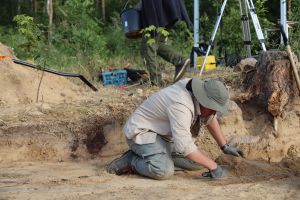A team of scientists from the AMU Faculty of Archaeology, led by Dr Danuta Żurkiewicz and Professor Iwona Sobkowiak-Tabaki, identified megalithic tombs dating back 5,500 years. The excavations were conducted as part of a scientific camp of the Faculty of Archaeology in the General Dezyder Chłapowski Landscape Park (Kościan commune, Wyskoć village). It is another discovery of the so-called “Polish pyramids” - earthen tombs erected by the communities of the Funicular Cup culture at the end of the Stone Age (Neolithic).
Source of the text below: naukawpolsce.pl
Earthen mounds from the Neolithic period in the village of Wyskoć (commune of Kościan) were discovered using remote sensing landscape analysis by employees of the Landscape Parks Complex of the Greater Poland Voivodeship (ZPKWW). The excavations at the site were conducted as part of a research camp of the AMU Faculty of Archaeology. The research was led by Dr Danuta Żurkiewicz and Dr Iwona Sobkowiak-Tabaka, Professor at the Adam Mickiewicz University.
Archaeological verification concerning the two objects, including excavation reconnaissance of one of them, confirmed the discoverers' assumptions that these are long earth tombs built 5.5 thousand years ago by the people of the Funerary Cup culture, i.e. at the end of the Stone Age (Neolithic), reported ZPKWW.
Megalithic tombs of the Kujawy type are considered to be among the largest sepulchral constructions erected in prehistory in Poland. Most similar constructions were discovered in Kuyavia, hence their name. They were pitched in the 4th millennium BC. They are also commonly called "Polish pyramids" or "beds of giants."
They were elongated earthen embankments from several dozen to nearly 200 metres long, erected on the plan of a strongly elongated triangle, whose base (the face of the megalith) was a dozen metres wide and about 4 metres high. The mound gradually narrowed and lowered, passing into the so-called tail.
The most significant boulders, weighing up to several tonnes, were placed at the head of the megalith. The stones were laid vertically and stabilised or raised with smaller stones. The face of the megalith was oriented to the east and the tail to the west. It is presumed that this form of tomb was intended to relate in shape to the long trapezoidal houses built by earlier Neolithic cultures.
"During the excavations, the remains of a structure made of stone were uncovered. The elements of the stone enclosure of this structure were captured very nicely. They have pushed around because 5,500 years have affected the structure, however, the major boulders that formed the front of the megalith are no longer there. For thousands of years, people have needed stone, so they picked up these stones, split them, and as a result, the object has been heavily degraded," Artur Golis, chief specialist in nature and landscape conservation from the Greater Poland Voivodeship Landscape Parks Complex, described to PAP.
Five ‘promising’ features were initially identified in the park. Two of them were found at the described site.
- Although the Funnel Cultures were relatively egalitarian communities, the tombs were used to bury people significant to the community - a leader, a priest, a shaman. Each generation of a community buried its megalith - as Golis explained.
The tombs usually contained a single skeletal burial. The body of the deceased was laid in an upright position on its back, with its legs pointing towards the front of the megalith, i.e. towards the east. It was furnished with grave goods and surrounded by a separate stone enclosure, sometimes covered with cobblestones.
- "The skeleton, in the case of this megalith, probably no longer survives, but the grave gifts might. They could potentially have been stone hatchets, axes, pottery or distinctive earthenware, including a so-called orifice flask - a small poppy-shaped vessel suggesting opium use. Perhaps some ornaments are already made of copper," supposes the PAP interviewee.
Constructions of this type were unknown in the Greater Poland region until 2019. At that time, a team of scientists from the AMU Faculty of Archaeology and the Archaeological Museum in Poznań tracked down five such tombs near Rokietnica with the help of airborne laser scanning (ALS). A year later, the archaeologists conducted excavations on a limited scale, which confirmed that the shapes drawn on the images do indeed show prehistoric tombs of the Kuyavian type. These structures were also identified in Sierpówek in the municipality of Szamotuły.
Ewelina Krajczyńska-Wujec (PAP)
Photo source: The Landscape Parks Complex of the Greater Poland Voivodeship (ZPKWW)
